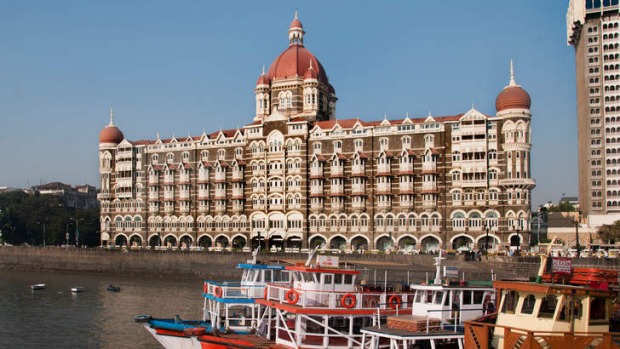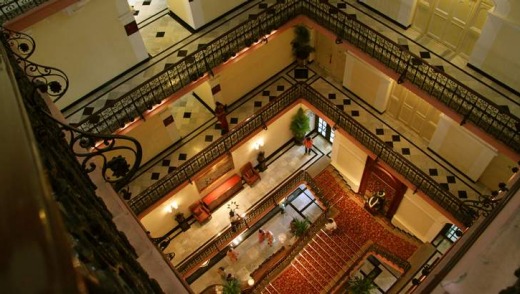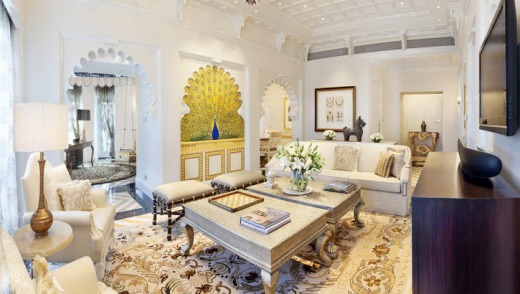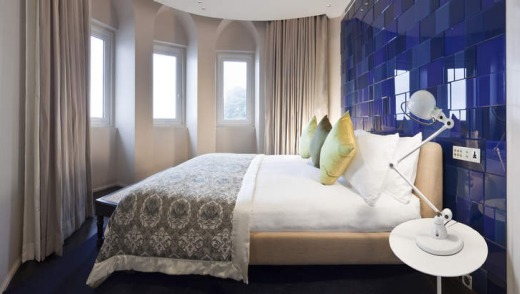
Richard Tulloch tours a historic palace - and lives in it like a prince.
Viren bounces with the enthusiasm of the young manager in the film Best Exotic Marigold Hotel. "I want you to take away a memory! I want you to have an experience! Please be careful, sir, if you step back to take that photo you will fall in the swimming pool."
We're not used to hotel introductions that last an hour and a half. A few minutes are normally ample to show us how to work the lights and find BBC World on TV.

Viren's passion for the history of the Taj Mahal Palace, combined with his theatrical flair when telling a story, encouraged his employers to allow him to work full-time researching the hotel's colourful past and leading daily heritage tours for guests.
There's plenty to tell. Mahatma Gandhi's bare feet padded up the carpet of the colonial staircase. Lord Mountbatten's speech in the grand ballroom ushered in Indian independence in 1947. Ravi Shankar taught George Harrison to play the sitar here.
The elaborate domes, the central one a replica of the cupola of Florence's cathedral, the light filtering through latticework onto the potted palms in the corridors, the glorious masses of fresh flowers and the turbaned doormen all point to an exclusive institution established by the British in the glory days of the Raj.

Quite wrong. The Taj is proudly Indian and always has been. Parsee industrialist Jamsetji Tata opened it in 1903 "for the common man", meaning Indian guests were welcomed, when most hotels of the day excluded them. Rooms cost from six rupees, at a time when a pound sterling bought 13 rupees.
The Taj was ahead of its time in other ways, too. It was the first hotel in India with electricity, elevators, ceiling fans, a fine dining Indian restaurant, and ensuite bathrooms. The first fashion parade in the country was held there. During both world wars it served as a hospital for soldiers.
The celebrity guest list could be transcribed directly from Who's Who. King George V and Queen Mary kicked things off by staying there in 1911. Since then, the hotel has hosted a constant stream of royals and presidents, sporting stars and film stars. Photos of Oprah Winfrey, Mick Jagger, Jacques Chirac, Prince Charles, Sachin Tendulkar and John Lennon tell us discreetly this is the place to stay when in Mumbai.

Viren goes around the nationalities in our tour group, rattling off the names of our more celebrated compatriots. My wife is associated with the former Dutch queen Beatrix. I score the Australian cricket team, Hugh Jackman, John Howard and Kylie Minogue.
In the Masala Kraft, one of 11 restaurants in the hotel, we share a superb modern Indian meal and learn we are sitting at Hillary Clinton's table. Famous or not, we are all treated to the highest level of service: friendly without being casual, attentive without being obsequious. We feel very comfortable here. My wife expresses interest in buying DVDs of particular Bollywood movies. The concierge locates them for her in no time.
Local Mumbai people have a particular fondness for the Taj, too. "They say all marriages are made in the Sea Lounge," staff member Nikhila says. She celebrated her engagement there, looking out at the ferries bobbing on the bay.
Viren grew up just down the street from the Taj and, as a child, came for ice-creams, and to run screaming with excitement down the echoing marble corridors.
The Tata business empire is renowned throughout India for its success and revered in Mumbai for its philanthropy. A share of the hotel's profits regularly goes to support local charities, and people spontaneously tell us of other generous gifts by the family.
On request, Viren runs art tours, too. The art on the hotel's walls comprises more than 4000 pieces, hundreds of them of museum-quality. During the 1950s and 60s, the hotel offered gallery space to up-and-coming artists in return for donations of unsold work. Over the years, some emerged to become India's greatest artists, incalculably increasing the value of the collection.
The witty interior of the iconic Joy Shoes shop is a work of art in itself. It was designed by India's most successful painter, M. F. Husain; this is ironic, since the artist notoriously went barefoot all his life.
At the end of Viren's heritage tour, we pause at a list of 32 names inscribed on the wall in a corner of the lobby. It can't be avoided. These people died in the terrorist attack on the hotel in November 2008. Among them are 12 members of the hotel staff and, poignantly, a dog. Including Lucy reminds us of the innocence of all the victims.
The Taj people naturally don't want those dreadful events to be all that the hotel is known for. It's one story in a continuing narrative. But they are justifiably proud of the heroism of staff members who placed the welfare of their guests above their own safety during those dark days.
As one of the first guests after the attacks noted in the visitors' book: "Your staff is a symbol of graciousness and resilience. Barack Obama."
The writer was the guest of the Taj Mahal Palace in Mumbai and Abercrombie & Kent.
FIVE MORE ADVENTURES IN MUMBAI
Since the trip begins in Mumbai, it's worth taking a couple of days to explore India's largest city.
GATEWAY OF INDIA
The archway just across from the hotel is perfect for viewing the boats on the bay, which means it's also crowded with tourists and their attendant hawkers.
BANGANGA TEMPLE
One of Mumbai's oldest and holiest sites is not a single building, but a cluster of shrines surrounding a pool of murky holy water.
GANDHI HOUSE
In the house that was Mahatma Gandhi's Bombay base from 1917 to 1934, dioramas, photos and documents tell his story.
BAZAARS
Visit Crawford Market and the Mumbai Spice Markets to pick up local colour, smells and possibly a few bargains.
KANHERI CAVES
A full-day excursion is needed to explore the ancient Buddhist caves in the Sanjay Gandhi National Park.
GETTING THERE
Singapore Airlines has a fare to Mumbai for about $1425 return from Sydney and Melbourne including tax.
Fly to Singapore (about eight hours) and then to Mumbai (five hours 25 minutes); see singaporeair.com.
Australians require a visa for a stay of up to six months.
STAYING THERE
Tower rooms at the Taj Mahal Palace from INR12150 ($218), palace rooms from INR22800.
The Heritage Tour for hotel guests is run daily at 5pm. Packages including transfers, guided tours of Mumbai and accommodation at Taj Mahal Palace can be arranged through Abercrombie & Kent, phone 1300 590 317.
TRIP NOTES MORE INFORMATION
tajhotels.com; abercrombiekent.co.in; incredibleindia.org.